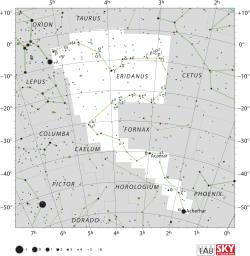Pi Eridani
| Pi Eridani (π) | |
 | |
| Observationsdata Epok: J2000.0 | |
|---|---|
| Stjärnbild | Eridanus |
| Rektascension | 03t 46m 08,53581s[1] |
| Deklination | -12° 06′ 05,7282″[1] |
| Skenbar magnitud () | +4,40[2] (4,38-4,44[3]) |
| Stjärntyp | |
| Spektraltyp | M1 III[4] |
| B–V | +1,61[2] |
| Variabeltyp | Långsam irreguljär variabel (Lb:) |
| Astrometri | |
| Radialhastighet () | 45,2 ± 0,1[5] km/s |
| Egenrörelse (µ) | RA: +55,98[1] mas/år Dek.: +59,28[1] mas/år |
| Parallax () | 6,78 ± 0,53[1] |
| Avstånd | 480 ± 40 lå (150 ± 10 pc) |
| Absolut magnitud () | -1,40[6] |
| Detaljer | |
| Radie | 77[7] R☉ |
| Luminositet | 1,123[8] L☉ |
| Temperatur | 3 841[8] K |
| Andra beteckningar | |
| π Eridani, πEri, 26 Eridani , BD -12 ° 707, HD 23614, HIP 17593, HR 1162, SAO 149158. [9] | |
Pi Eridani (π Eridani, förkortat Pi Eri, π Eri) som är stjärnans Bayerbeteckning, är en ensam stjärna belägen i den mellersta delen av stjärnbilden Eridanus. Den har en skenbar genomsnittlig skenbar magnitud på 4,40[2], är svagt synlig för blotta ögat där ljusföroreningar ej förekommer och är en långsam oregelbunden variabel av typ LB, som kan öka i magnitud upp till 4,38.[3][10] Baserat på parallaxmätning inom Hipparcosuppdraget på ca 6,8[1] mas, beräknas den befinna sig på ett avstånd på ca 480 ljusår (ca 40 parsek) från solen.
Egenskaper
[redigera | redigera wikitext]Pi Eridani är en röd pulserande jättestjärna av spektralklass M1 III[4] och befinner sig för närvarande på den asymptotiska jättegrenen[11]. Den har en radie som är ca 77[7] gånger större än solens och utsänder från dess fotosfär ca 12[8] procent mera energi än solen vid en effektiv temperatur på ca 3 840[8] K.
Källor
[redigera | redigera wikitext]- Den här artikeln är helt eller delvis baserad på material från engelskspråkiga Wikipedia, tidigare version.
Referenser
[redigera | redigera wikitext]- ^ [a b c d e f] van Leeuwen, F. (2007), "Validation of the new Hipparcos reduction", Astronomy and Astrophysics, 474 (2): 653–664, arXiv:0708.1752 , Bibcode:2007A&A...474..653V, doi:10.1051/0004-6361:20078357.
- ^ [a b c] Mermilliod, J.-C. (1986), Compilation of Eggen's UBV data, transformed to UBV (unpublished), SIMBAD, Bibcode:1986EgUBV........0M.
- ^ [a b] Samus, N. N.; Durlevich, O. V.; et al. (2007), Combined General Catalogue of Variable Stars (GCVS4.2), retrieved 2016-09-30. VizieR On-line Data Catalog: B/gcvs.
- ^ [a b] Houk, N.; Smith-Moore, M. (1988), Michigan Catalogue of Two-dimensional Spectral Types for the HD Stars, 4, Bibcode:1988MSS...C04....0H.
- ^ Gontcharov, G. A. (November 2006), "Pulkovo Compilation of Radial Velocities for 35 495 Hipparcos stars in a common system", Astronomy Letters, 32 (11): 759–771, arXiv:1606.08053 , Bibcode:2006AstL...32..759G, doi:10.1134/S1063773706110065.
- ^ Anderson, E.; Francis, Ch. (2012), "XHIP: An extended hipparcos compilation", Astronomy Letters, 38 (5): 331, arXiv:1108.4971 , Bibcode:2012AstL...38..331A, doi:10.1134/S1063773712050015.
- ^ [a b] Lang, Kenneth R. (2006), Astrophysical formulae, Astronomy and astrophysics library, 1 (3 ed.), Birkhäuser, ISBN 3-540-29692-1. The radius (R*) is given by::
- ^ [a b c d] McDonald, I.; et al. (2012), "Fundamental Parameters and Infrared Excesses of Hipparcos Stars", Monthly Notices of the Royal Astronomical Society, 427 (1): 343–57, arXiv:1208.2037 , Bibcode:2012MNRAS.427..343M, doi:10.1111/j.1365-2966.2012.21873.x.
- ^ pi. Eri". SIMBAD. Centre de données astronomiques de Strasbourg. Hämtad 2016-10-11.
- ^ Mennessier, M. O.; et al. (August 2001), "Long period variable stars: galactic populations and infrared luminosity calibrations", Astronomy and Astrophysics, 374: 968–979, arXiv:astro-ph/0105552 , Bibcode:2001A&A...374..968M, doi:10.1051/0004-6361:20010764.
- ^ Eggen, O. J. (1992), "Asymptotic giant branch stars near the sun", The Astronomical Journal, 104: 275, Bibcode:1992AJ....104..275E, doi:10.1086/116239.






